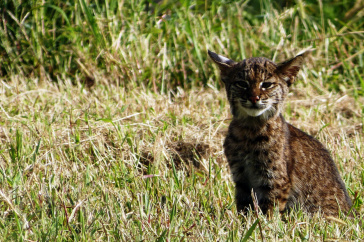The University of New Hampshire inspires innovation and transforms lives in our state, nation and world. More than 16,000 students from all 50 states and 71 countries engage with an award-winning faculty in top-ranked programs in business, engineering, law, health and human services, liberal arts and the sciences across more than 200 programs of study. A Carnegie Classification R1 institution, UNH partners with NASA, NOAA, NSF and NIH, and received $260 million in competitive external funding in FY21 to further explore and define the frontiers of land, sea and space.
UNH Research Finds N.H. Bobcats Roam in Different Areas than Ancestors

A young bobcat at the Mattamuskeet National Wildlife Refuge in North Carolina. Credit: Allie Stewart, USFWS.
DURHAM, N.H.—In the last 60 years, northern New England’s bobcats have changed how they roam the region, with bobcats today moving from north to south as areas that once were “net exporters” of these native wild cats are now “net importers,” according to new research from the New Hampshire Agricultural Experiment Station at the University of New Hampshire.
“While our results do not currently rise to the level of a crisis, they do highlight the wide-reaching impacts humans have on wildlife populations,” said Rory Carroll, doctoral candidate in earth and environmental sciences, who conducted the research with Marian Litvaitis, professor of natural resources and the environment. “As human populations continue to grow and we continue to alter landscapes, the negative effects we have on wildlife species also increase. All signs point to a robust bobcat population right now in New Hampshire, but because they have such large ranges, they are always susceptible to environmental changes brought on by humans.”
Using DNA from bobcat skulls collected by state agencies since the 1950s and 1960s, Litvaitis and Carroll examined decades of the population genetic patterns of bobcats across northern New England. In this study, the genetic data gave researchers two snapshots of bobcat movement and diversity patterns over time. They found that bobcats, whose numbers have increased over time, have changed how they move across the landscape given the increase in the number of roads and amount of development. Genetic diversity has somewhat decreased, and the population is more divided due to natural and human-built barriers.
Historically, bobcats thrived in southern areas where there were better habitats. Many young cats were born in southern areas. When they then set out to establish their own new home ranges, some had to head north into less optimal habitat. Today, the roaming patterns of bobcats are reversed: cats are thriving in the north and moving south to establish new home ranges.
“We hypothesize that pattern reversed for two reasons,” he said. “First, there has been a substantial decrease in snowfall in New Hampshire as a result of climate change. Our earlier work showed snow depth limited the distribution of bobcats. Hence, the northern part of the state is now better habitat than it was historically. Second, the south likely has become less hospitable because that is where the greatest amount of development has occurred. In addition, hunting practices across the region and a higher abundance of prey in developed areas, such as the squirrels that visit your bird feeder, also are likely impacting the movement of bobcats. Overall, bobcats are much more abundant today than they were in the 1950s and 1960s.”
Researchers also discovered that some highways aligned with barriers to bobcat movement while others did not. Carroll explained that the presence of subpopulations of bobcats suggests that there is less bobcat movement going between subpopulations than there is within subpopulations.
“There is some sort of an ecological or physical barrier between the subpopulations that makes bobcats reluctant to cross. Some borders between subpopulations aligned closely with the location of highways, especially parts of I-89. However, other parts of I-89 didn't appear to be a barrier, and some of the sharpest divisions between subpopulations did not correspond to the presence of a highway or any other obvious physical feature,” he said.
Broadly, Litvaitis and Carroll are investigating how humans can affect wildlife species, using bobcats as a case study. They hypothesize that an abundance of new food sources in human-dominated areas may make bobcats less likely to move away from those areas, even though they can.
“The large carnivores that used to roam across New Hampshire—mountain lions and wolves—have been eliminated,” he said. “Smaller predators like bobcats and coyotes are now the top predators in the region. Those species have a disproportionately large impact on wildlife communities so it’s critical that we keep their populations healthy. The more knowledge we have about the biology and ecology of bobcat populations, the better we will be able to conserve and coexist with them.”
This research is presented in the journal Conservation Genetics. This material is based upon work supported by the NH Agricultural Experiment Station, through joint funding of the National Institute of Food and Agriculture, U.S. Department of Agriculture, under award number 233076 1009906, and the state of New Hampshire. This work also was supported by the National Science Foundation Graduate Research Fellowship program, UNH Graduate School Dissertation Year Fellowship, New Hampshire Fish and Game Department, Vermont Fish and Wildlife Department, Massachusetts Division of Fisheries and Wildlife, Quebec Ministry of Forests, Wildlife, and Parks, and individual hunters and trappers.
Founded in 1887, the NH Agricultural Experiment Station at the UNH College of Life Sciences and Agriculture is UNH’s original research center and an elemental component of New Hampshire's land-grant university heritage and mission.
PHOTO AVAILABLE FOR DOWNLOAD:
https://colsa.unh.edu/nhaes/sites/default/files/media/images/bobcat.jpg
A young bobcat at the Mattamuskeet National Wildlife Refuge in North Carolina. Credit: Allie Stewart, USFWS.
-
Media Contact
Lori Tyler Gula, PhD | NH Agricultural Experiment Station | lori.gula@unh.edu | 603-862-1452
Latest News
-
October 24, 2025
-
October 8, 2025
-
October 2, 2025
-
September 24, 2025
-
September 15, 2025














































